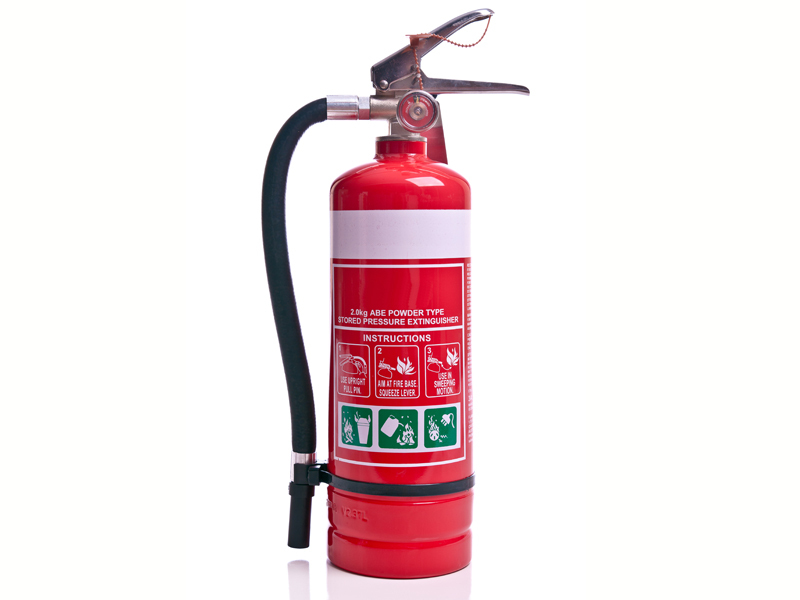As a restaurant or even house owner yourself, you know how dangerous your kitchen can be. A small mistake can lead to a major fire hazard that can cause huge losses in both the properties and lives of the surrounding people.
So it’s always better to be safe than sorry. Besides taking precautious steps in maintaining your kitchen’s safety such as having a regular check-up on the kitchen equipment or clean your canopy system routinely, one simple but important thing you can do is to have and know how to use fire extinguisher properly.
In this complete guide on fire extinguisher for kitchen, we will explain each and everything you need to know. So let’s dive right in.
What Is It?
According to the definition, a fire extinguisher is is an active fire protection device used to extinguish or control small fires, often in emergency situations. It typically consists of a hand-held cylindrical pressure vessel, containing an agent that can be discharged to distinguish fire.
The cylindrical pressure vessel is generally made of aluminum alloy whereas the extinguishing agent comes with different formula. Each formula is designed to deal with a different class of fire, in which we will discuss later.
Why Do You Need One?


A fire extinguisher helps keep your kitchen safe by extinguishing small fire that can leads to a big fire breakout. Besides the safety reason, it is also required by laws in most of the countries that any commercial restaurant should have at least one in their kitchens.
Due to it’s compact size and quick-to-use in nature, a fire extinguisher can help extinguish fire in a matter of minutes, which can help save lives and properties.
6 Classes Of Fire In Australia
According to the government of Australia, a fire has been classified into 6 types, in which each of the fire extinguisher type will be rated against in its labelling.
The 6 classes of fire are as follows:
- Class A fires – combustible materials: caused by flammable solids, such as wood, paper, and fabric
- Class B fires – flammable liquids: such as petrol, turpentine or paint
- Class C fires – flammable gases: like hydrogen, butane or methane
- Class D fires – combustible metals: chemicals such as magnesium, aluminum or potassium
- Class E Fires – electrical equipment: once the electrical item is removed, the fire changes class
- Class F fires – cooking oils: typically a chip-pan fire
5 Types
So now you know the 6 classes of fire. Next, let’s understand the 5 common types of fire extinguisher and which type is suitable for which class of fire.
1. Water and Foam
Water (red labelled) and foam (blue labelled) extinguish fire by taking away the heat from the fire triangle. Foam elements also help separate oxygen from the fire element.
They can only be used for Class-A fire and should not be used on Class B or C fires.
2. Carbon Dioxide (CO2)
Carbon Dioxide (black labelled) is one of the most common types of fire extinguisher available. It works by separating oxygen from the fire element and helps taking the heat away with a very cold discharge.
This type of extinguisher can be used on Class-B and C fires.
3. Dry Chemical
Dry Chemical fire extinguishers extinguish the fire primarily by interrupting the chemical reaction of the fire triangle. It is effective with the Class-A, B, and C fires.
4. Wet Chemical
Wet chemical (oatmeal labelled) is a new agent that extinguishes the fire by removing the heat of the fire triangle and prevents re-ignition by creating a barrier between the oxygen and fuel elements.
It is suitable for the Class-A and F fires.
5. Dry Powder
Last but not least, dry powder (white labelled) works similar to dry chemical, except that they extinguish the fire by separating the fuel from the oxygen element or by removing the heat element of the fire triangle
It is only suitable for Class-D fire, and ineffective with other classes.
How To Use
Before knowing how to operate the extinguisher, you should make sure the following precautions and points are taken care of:
- Make sure the fire extinguisher you select is large enough to discharge the fire. This is because the larger the fire, the longer the discharge time.
- Properly locate the fire and make sure that the fire has not spread.
- Make sure to test it before use and have at least one more person to assist you.
- Always have a backup fire extinguisher ready.
Once the above points are noted, let’s move on to how to operate a fire extinguisher.
Most fire extinguishers operate using the following P.A.S.S. technique:
1. PULL
The first step is to pull the pin located at the top end of the fire extinguisher. This will also break the tamper seal.
2. AIM
Next step is to aim low, pointing the extinguisher nozzle (or its horn or hose) at the base of the fire.
3. SQUEEZE
Then squeeze the handle to release the extinguishing agent.
4. SWEEP
The last step is to sweep from side to side at the base of the fire until it appears to be out. Make sure to watch out for any re-ignition sign.
FAQ
1. How many should you have in your kitchen?
It is mandatory for most of the commercial restaurants to have at least one fire extinguisher in the kitchen. However, we recommend to have at least 2-3 for back-ups, in case one doesn’t work or there are multiple fire breakouts.
2. Where should they be placed in a kitchen?
Fire extinguishers should be situated at least 1 meter away from the stove, between the stove and the nearest exit.
3. How do I know if my fire extinguisher is still good?
Most fire extinguishers come with a pressure gauge that indicates the pressure level of the internal contents. If the gauge needle falls too low (you can tell if it is outside the green zone on the gauge), you know it’s time to replace your extinguisher.
4. What type of a fire extinguisher should be used for a commercial kitchen?
The wet chemical type of extinguisher should be used for a commercial kitchen. This is because it is suitable for Class-F fires, which involve cooking-based products.
